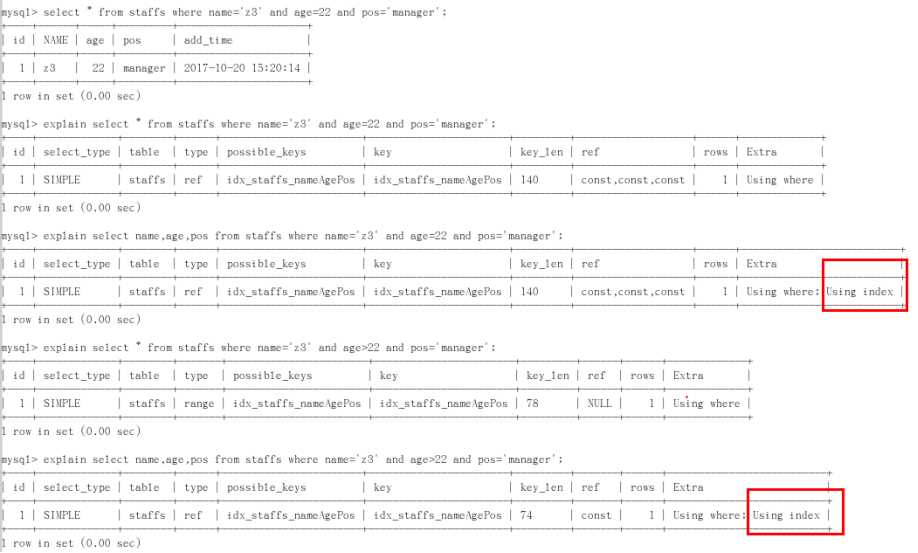Mysql优化
Posted lys-lyy
tags:
篇首语:本文由小常识网(cha138.com)小编为大家整理,主要介绍了Mysql优化相关的知识,希望对你有一定的参考价值。
1. 策略1.尽量全值匹配

CREATE TABLE `staffs`(
id int primary key auto_increment,
name varchar(24) not null default "" comment‘姓名‘,
age int not null default 0 comment ‘年龄‘,
pos varchar(20) not null default "" comment‘职位‘,
add_time timestamp not null default current_timestamp comment ‘入职时间‘
)charset utf8 comment ‘员工记录表‘;
insert into staffs(name,age,pos,add_time) values(‘z3‘,22,‘manage‘,now());
insert into staffs(name,age,pos,add_time) values(‘july‘,23,‘dev‘,now());
insert into staffs(name,age,pos,add_time) values(‘2000‘,23,‘dev‘,now());
alter table staffs add index idx_staffs_nameAgePos(name,age,pos);
EXPLAIN SELECT * FROM staffs WHERE NAME = ‘July‘;
EXPLAIN SELECT * FROM staffs WHERE NAME = ‘July‘ AND age = 25;
EXPLAIN SELECT * FROM staffs WHERE NAME = ‘July‘ AND age = 25 AND pos = ‘dev‘
当建立了索引列后,能在wherel条件中使用索引的尽量所用。
2. 策略2.最佳左前缀法则
如果索引了多列,要遵守最左前缀法则。指的是查询从索引的最左前列开始并且不跳过索引中的列(和顺序无关,但是不能丢)。

EXPLAIN SELECT * FROM staffs WHERE age = 25 AND pos = ‘dev‘
EXPLAIN SELECT * FROM staffs WHERE pos = ‘dev‘
EXPLAIN SELECT * FROM staffs WHERE NAME = ‘July‘
3. 策略3.不在索引列上做任何操作
不在索引列上做任何操作(计算、函数、(自动or手动)类型转换),会导致索引失效而转向全表扫描

EXPLAIN SELECT * FROM staffs WHERE NAME = ‘July‘;
EXPLAIN SELECT * FROM staffs WHERE left(NAME,4) = ‘July‘;
4. 策略4.范围条件放最后

EXPLAIN SELECT * FROM staffs WHERE NAME = ‘July‘ ;
EXPLAIN SELECT * FROM staffs WHERE NAME = ‘July‘ and age =22;
EXPLAIN SELECT * FROM staffs WHERE NAME = ‘July‘ and age =22 and pos=‘manager‘
中间有范围查询会导致后面的索引列全部失效
EXPLAIN SELECT * FROM staffs WHERE NAME = ‘July‘ and age >22 and pos=‘manager‘
5. 策略5.覆盖索引尽量用

尽量使用覆盖索引(只访问索引的查询(索引列和查询列一致)),减少select *
EXPLAIN SELECT * FROM staffs WHERE NAME = ‘July‘ and age =22 and pos=‘manager‘
EXPLAIN SELECT name,age,pos FROM staffs WHERE NAME = ‘July‘ and age =22 and pos=‘manager‘
EXPLAIN SELECT * FROM staffs WHERE NAME = ‘July‘ and age >22 and pos=‘manager‘
EXPLAIN SELECT name,age,pos FROM staffs WHERE NAME = ‘July‘ and age >22 and pos=‘manager‘
6.策略6.不等于要甚用
mysql 在使用不等于(!= 或者<>)的时候无法使用索引会导致全表扫描

EXPLAIN SELECT * FROM staffs WHERE NAME = ‘July‘;
EXPLAIN SELECT * FROM staffs WHERE NAME != ‘July‘;
EXPLAIN SELECT * FROM staffs WHERE NAME <> ‘July‘;
如果定要需要使用不等于,请用覆盖索引
EXPLAIN SELECT name,age,pos FROM staffs WHERE NAME != ‘July‘;
EXPLAIN SELECT name,age,pos FROM staffs WHERE NAME <> ‘July‘;
7. 策略7.Null/Not 有影响
注意null/not null对索引的可能影响
7.1. 自定定义为NOT NULL


EXPLAIN select * from staffs where name is null
EXPLAIN select * from staffs where name is not null
在字段为not null的情况下,使用is null 或 is not null 会导致索引失效
解决方式:覆盖索引
EXPLAIN select name,age,pos from staffs where name is not null
7.2. 自定义为NULL或者不定义

EXPLAIN select * from staffs2 where name is null

EXPLAIN select * from staffs2 where name is not null

EXPLAIN select * from staffs2 where name is not null

Is not null 的情况会导致索引失效
解决方式:覆盖索引
EXPLAIN select name,age,pos from staffs where name is not null
8. 策略8.Like查询要当心
like以通配符开头(‘%abc...‘)mysql索引失效会变成全表扫描的操作

EXPLAIN select * from staffs where name =‘july‘
EXPLAIN select * from staffs where name like ‘%july%‘
EXPLAIN select * from staffs where name like ‘%july‘
EXPLAIN select * from staffs where name like ‘july%‘
解决方式:覆盖索引
EXPLAIN select name,age,pos from staffs where name like ‘%july%‘
9. 策略9.字符类型加引号
字符串不加单引号索引失效

EXPLAIN select * from staffs where name = 917
解决方式:覆盖索引
EXPLAIN select name,age,pos from staffs where name = 917
解决方式:请加引号
10. 策略10.OR改UNION效率高

EXPLAIN
select * from staffs where name=‘July‘ or name = ‘z3‘
EXPLAIN
select * from staffs where name=‘July‘
UNION
select * from staffs where name = ‘z3‘
解决方式:覆盖索引
EXPLAIN
select name,age from staffs where name=‘July‘ or name = ‘z3‘
以上是关于Mysql优化的主要内容,如果未能解决你的问题,请参考以下文章